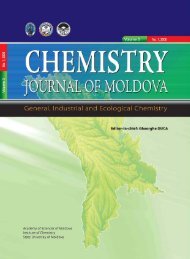2011, nr. 1 - Academia de Ştiinţe a Moldovei
2011, nr. 1 - Academia de Ştiinţe a Moldovei
2011, nr. 1 - Academia de Ştiinţe a Moldovei
You also want an ePaper? Increase the reach of your titles
YUMPU automatically turns print PDFs into web optimized ePapers that Google loves.
<strong>Ştiinţe</strong> Medicale<br />
5. Fagard R. H. Sympathetic activity, assessed by<br />
power spectral analysis of heart rate variability, in whitecoat,<br />
masked and sustained hypertension versus true normotension.<br />
J Hypertens, 2007; 25(11):2280-2285.<br />
6. Hansen T. W. Ambulatory blood pressure monitoring<br />
and mortality: a population-based study. Hypertension,<br />
2005; 45: 499–504.<br />
7. Ohkubo T., Pronostic significance of the nocturnal<br />
<strong>de</strong>cline in BP in individuals with and without high 24 h blood<br />
pressure.J Hypertens 2002(2)83 89.<br />
8. Gudmundsson L. S. Migraine patients have lower<br />
systolic but higher diastolic blood pressure compared with<br />
controls in a population – based study. Th e Reykjavik study.<br />
Cephalalgia, 2006; 26:436-444.<br />
9. Bigal M. E. Concept of migraine cronifi cation. Headache,<br />
2008; 48:7-15.<br />
10. Hamed S. A. Th e vascular risk asociations with<br />
migraine relation to migraine susceptibility and progresion.<br />
Atherosclerosis, 2008; 205:15-22.<br />
11. Barbanti P. Hipertension as a risk for migraine cronifi<br />
cation. Neuro Sci., 2010; 31: 41-43.<br />
12. Th e International Classifi cation of Headache Disor<strong>de</strong>rs.<br />
Cephalalgia, 2004; Sp. 1.<br />
13. Working Group on Primary Prevention of Hypertension<br />
(1993). National high blood pressure education program<br />
working group report on primary prevention of hypertension.<br />
Cephalalgia, 153:186.<br />
14. Th e Task Force for the Management of Arterial<br />
Hypertension of the European Society of Hypertension and<br />
of the European Society of Cardiology. J. Hypertens., 2007;<br />
25:1105–1187.<br />
15. Stolarz-Skrzypek K.<br />
Blood pressure variability in<br />
relation to outcome in the International Database of Ambulatory<br />
blood pressure. Hypertens. Research, 2010; 33:757–<br />
766.<br />
16. Grassi G. Adrenergic, metabolic, and refl ex abnormalities<br />
in reverse and extreme dipper hypertensives.<br />
Hypertension, 2008; 52:925–931.<br />
17. Montalcini T. Association between pulse pressure<br />
and subclinical carotid atherosclerosis in normotensive and<br />
hypertensive postmenopausal women. Clin. Exp. Hypertens.,<br />
2009; 31:64–70.<br />
18. Safar M. E.<br />
Pulse pressure in essential hypertension:<br />
clinical and therapeutical implications. J. Hypertens.,<br />
1989; 7:769–776.<br />
19. Hamed S. A. Th e vascular risk asociations with<br />
migraine relation to migraine susceptibility and progresion.<br />
Atherosclerosis, 2008; 205:15-22.<br />
75<br />
Rezumat<br />
Monitorizarea ambulatorie a tensiunii arteriale<br />
(MATA) este o metodă neinvazivă <strong>de</strong> evaluare a hipertensiunii<br />
arteriale, ce permite stratifi carea și prezicerea riscului<br />
cardiovascular și corelează cu afectarea organelor-ţintă.<br />
Cu ajutorul acestei meto<strong>de</strong> se poate stabili indicele diurn<br />
și al patternului circadian al tensiunii arteriale: ”dipper”,<br />
”non-dipper”, ”overdipper” sau ”reverce dipper”. Scopul<br />
studiului a fost analiza MATA într-un subgrup îngust <strong>de</strong><br />
pacienţi: cu migrenă și hipertensiune arterială. Studiul a<br />
<strong>de</strong>terminat utilitatea meto<strong>de</strong>i MATA în managementul<br />
acestor bolnavi și a stabilit că în grupul cu pattern ”nondipping”<br />
istoricul <strong>de</strong> cefalee este mai în<strong>de</strong>lungat <strong>de</strong>cât în<br />
grupul ”dipping”, refl ectând modifi cările pe care le induce<br />
cefaleea <strong>de</strong> lungă durată asupra reglării neuroumorale a<br />
sistemului cardiovascular.<br />
Summary<br />
Ambulatory blood pressure monitoring (ABPM) is a<br />
noninvasive tool to evaluate hypertensive patients, which<br />
allow the stratifi cation of cardiovascular risk and end-organ<br />
damage. Using this instrument the clinician can establish<br />
the diurnal blood pressure rhythm: ”dipper”, ”non-dipper”,<br />
”over dipper” or ”reverse dipper”. Th e study objectives<br />
were to perform ABMP in a special group of migraine<br />
patients with arterial hypertension. Th e results revealed the<br />
usefulness of the technique in such a subpopulation and<br />
establish that in the group of “non-dipping“ diurnal blood<br />
pressure rhythm the headache duration was longer than<br />
in “dipper” group which refl ect the modifi cation headache<br />
can produce on cardiovascular autonomic regulation.<br />
Резюме<br />
Суточный мониторинг артериального давления<br />
(СМАД) является неинвазивным методом выявления<br />
и оценки артериальной гипертензии для определения<br />
кардиоваскулярного риска и нагрузки на органымишени.<br />
Этот метод определяет суточный ритм, ночное<br />
снижение артериального давления, что позволяет<br />
классифицировать пациентов как: “дипперы”, “нондипперы”,<br />
“овердипперы”, “найтпикеры“. Задачей исследования<br />
было суточное мониторизирование артериального<br />
давления для узкой подгруппы больных – с<br />
мигренью и артериальной гипертензией. Исследование<br />
показало, что метод незаменим для ведения таких<br />
пациентов. Установлено что в группе ”нондипперов”,<br />
с недостаточным ночным снижением артериального<br />
давления, анамнез головной боли дольше, чем в группе<br />
с оптимальным ночным снижением. Это показывает<br />
влияние длительной головной боли на автономную<br />
регуляцию кардиоваскулярной системы.

















